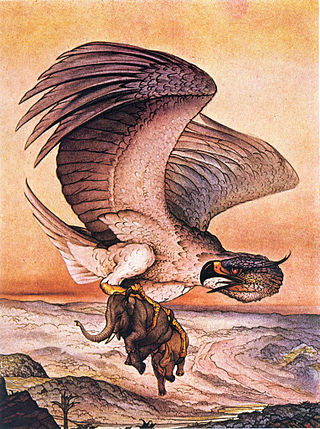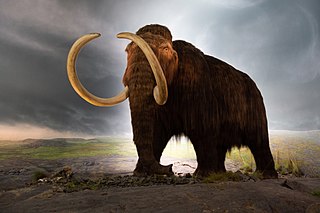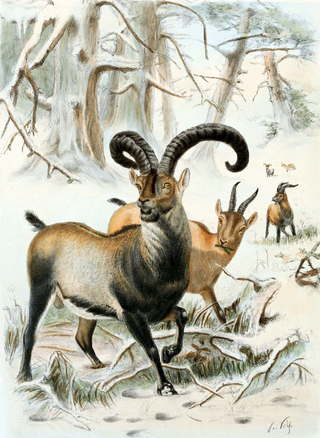
The bunyip is a creature from the aboriginal mythology of southeastern Australia, said to lurk in swamps, billabongs, creeks, riverbeds, and waterholes.

A mammoth is any species of the extinct elephantid genus Mammuthus. The various species of mammoth were commonly equipped with long, curved tusks. They lived from the late Miocene epoch into the Holocene about 4,000 years ago, and various species existed in Africa, Europe, Asia, and North America. Mammoths are more closely related to living Asian elephants than African elephants.

Proboscidea is a taxonomic order of afrotherian mammals containing one living family (Elephantidae) and several extinct families. First described by J. Illiger in 1811, it encompasses the elephants and their close relatives. Proboscideans include some of the largest known land mammals. The largest land mammal of all time may have been a proboscidean; the elephant Palaeoloxodon namadicus has been estimated to be up to 5.2 m (17.1 ft) at the shoulder and may have weighed up to 22 t, surpassing the paraceratheres, the otherwise largest known land mammals, though this estimate was made based on a single fragmentary femur and is speculative. The largest extant proboscidean is the African bush elephant, with a record of size of 4 m (13.1 ft) at the shoulder and 10.4 t. In addition to their enormous size, later proboscideans are distinguished by tusks and long, muscular trunks, which were less developed or absent in early proboscideans.

The roc is an enormous legendary bird of prey in the popular mythology of the Middle East.

Haast's eagle is an extinct species of eagle that lived in the South Island of New Zealand, commonly accepted to be the pouākai of Māori mythology. It is the largest eagle known to have existed, with an estimated weight of 15 kilograms, compared to the next-largest and extant harpy eagle, at up to 9 kg (20 lb). Its massive size is explained as an evolutionary response to the size of its prey—the flightless moa—the largest of which could weigh 230 kg (510 lb). Haast's eagle became extinct around 1445, following the arrival of the Māori, who hunted moa to extinction, introduced the Polynesian rat, and destroyed large tracts of forest by fire.

The term Australian megafauna refers to the megafauna in Australia during the Pleistocene Epoch. Most of these species became extinct during the latter half of the Pleistocene, and the roles of human and climatic factors in their extinction are contested.

Dwarf elephants are prehistoric members of the order Proboscidea which, through the process of allopatric speciation on islands, evolved much smaller body sizes in comparison with their immediate ancestors. Dwarf elephants are an example of insular dwarfism, the phenomenon whereby large terrestrial vertebrates that colonize islands evolve dwarf forms, a phenomenon attributed to adaptation to resource-poor environments and lack of predation and competition.

The pygmy mammoth or Channel Islands mammoth is an extinct species of dwarf elephant native to the northern Channel Islands off the coast of California. It was descended from the Columbian mammoth of mainland North America.

Mpinguari, or Mpinguary, are mythical monstrous jungle-dwelling spirits from Brazilian folklore said to protect the forest and its animals.
Fire-stick farming, also known as cultural burning and cool burning, is the practice of Aboriginal Australians regularly using fire to burn vegetation, which has been practised for thousands of years. There are a number of purposes for doing this special type of controlled burning, including to facilitate hunting, to change the composition of plant and animal species in an area, weed control, hazard reduction, and increase of biodiversity.

The Columbian mammoth is an extinct species of mammoth that inhabited the Americas from southern Canada to Costa Rica during the Pleistocene epoch. The Columbian mammoth descended from Eurasian mammoths that colonised North America during the Early Pleistocene around 1.5–1.3 million years ago, and later experienced hybridisation with the woolly mammoth lineage. The Columbian mammoth was among the last mammoth species, and the pygmy mammoths evolved from them on the Channel Islands of California. The closest extant relative of the Columbian and other mammoths is the Asian elephant.

During the Last Glacial Maximum, the mammoth steppe, also known as steppe-tundra, was once the Earth's most extensive biome. It stretched east-to-west, from the Iberian Peninsula in the west of Europe, across Eurasia to North America, through Beringia and Canada; from north-to-south, the steppe reached from the arctic islands southward to China. The mammoth steppe was cold and dry, and relatively featureless, though topography and geography varied considerably throughout. Some areas featured rivers which, through erosion, naturally created gorges, gulleys, or small glens. The continual glacial recession and advancement over millennia contributed more to the formation of larger valleys and different geographical features. Overall, however, the steppe is known to be flat and expansive grassland. The vegetation was dominated by palatable, high-productivity grasses, herbs and willow shrubs.
Geomythology is the study of oral and written traditions created by pre-scientific cultures to account for, often in poetic or mythological imagery, geological events and phenomena such as earthquakes, volcanoes, floods, tsunamis, land formation, fossils, and natural features of the landscape. Dorothy Vitaliano, a geologist at Indiana University, coined the term in 1968.

Mammuthus trogontherii, sometimes called the steppe mammoth, is an extinct species of mammoth that ranged over most of northern Eurasia during the Early and Middle Pleistocene, approximately 1.7 million-200,000 years ago. One of the largest mammoth species, it evolved in East Asia during the Early Pleistocene, around 1.8 million years ago, before migrating into North America around 1.5 million years ago, and into Europe during the Early/Middle Pleistocene transition, around 1 to 0.7 million years ago. It was the ancestor of the woolly mammoth and Columbian mammoth of the later Pleistocene.

The woolly mammoth is an extinct species of mammoth that lived from the Middle Pleistocene until its extinction in the Holocene epoch. It was one of the last in a line of mammoth species, beginning with the African Mammuthus subplanifrons in the early Pliocene. The woolly mammoth began to diverge from the steppe mammoth about 800,000 years ago in Siberia. Its closest extant relative is the Asian elephant. The Columbian mammoth lived alongside the woolly mammoth in North America, and DNA studies show that the two hybridised with each other.

The revival of the woolly mammoth is a proposed hypothetical that frozen soft-tissue remains and DNA from extinct woolly mammoths could be a means of regenerating the species. Several methods have been proposed to achieve this goal, including cloning, artificial insemination, and genome editing. Whether or not it is ethical to create a live mammoth is debated.

De-extinction is the process of generating an organism that either resembles or is an extinct species. There are several ways to carry out the process of de-extinction. Cloning is the most widely proposed method, although genome editing and selective breeding have also been considered. Similar techniques have been applied to certain endangered species, in hopes to boost their genetic diversity. The only method of the three that would provide an animal with the same genetic identity is cloning. There are benefits and drawbacks to the process of de-extinction ranging from technological advancements to ethical issues.
Colossal Biosciences is a biotechnology and genetic engineering company working to de-extinct the woolly mammoth, the Tasmanian tiger, and the dodo. In 2023, it stated that it wants to have woolly mammoth hybrid calves by 2028, and wants to reintroduce them to the Arctic tundra habitat. Likewise, it launched the Tasmanian Thylacine Advisory Committee, a thylacine research project to release Tasmanian tiger joeys back to their original Tasmanian and broader Australian habitat after a period of observation in captivity.














